Table of Contents
Every Cool Garden Needs These Blue Plants and Flowers
A splash of blue can elevate any garden landscape, drawing the eye to a particular area as well as attracting pollinators and human visitors alike.
What Makes A Cool Garden
A cool garden is open to interpretation but generally will feature a sense of drama and fun coupled with highly artistic design. This garden sets itself apart from others in that instead of just looking out the window or walking by; you want to stay awhile.
A fantastic garden design includes color, contrast, diversity, harmony, proportion, repetition, and a cohesive visual presence.
Details like water elements, tiled walkways, outdoor lighting, seating areas, and trailing plants over walls can give a sense that this incredible garden should be lived in as well as admired.
Why Add Blue Plants and Flowers To Your Garden
An addition that every garden needs: a vibrant pop of color. We've seen loads of white, yellow, pink, and red blooms on every end of the spectrum. Sometimes an unexpected mix of these can create a fiery show. However, a vibrant blue plant or tree will take your garden to the next level of interest.
Cool Elegance
Adding blue blooms to your garden will give it an elegant feel and cool ambiance. A large presence of blue can create a strong visual anchor point to your garden and give it a dynamic feel.
Symbolic Meaning
In addition, blue flowers can have special significance. For example, the blue bloom was once a symbol of the Romanticism movement standing for love, desire and a metaphysical yearning for the unreachable.
Pollinator Partners
Pollinators love bright blue blooms, and science has shown that bees, in particular, are attracted to those with blue halos. Nearly 80% of all pollination comes from honeybees, who are especially attracted to bright blue and violet colors.
Creates Calm
Adding blue hues to your garden in any form, from benches to planters, can induce a sense of tranquility and calm. Sprinkling them throughout can help break up color blocks and create a sense of continuity.
They Are Extraordinary
Besides coming in otherworldly shades of blue, they are somewhat rare. Of the 280,000 flowering plants on earth, just 10% are a shade of blue. Natural blue flowers are a rarity because there is no true blue pigment in the plant kingdom. Instead, plants rely on tricks of light to appear blue.
Why Are We Attracted To Blue Flowers
Because only 1 in 10 flowering plants is blue, they are considered prized and exotic by gardeners. However, in the natural world, where the color is so rare, adding blue to your garden landscape is like creating a fairytale.
How To Use Blue Flowers and Plants In Your Landscape
We are used to warm colors in our gardens; yellow, pink, and oranges. Adding the cool tone of blue serves to disrupt our visual norm. Because using too many primary colors can become tiring for the eye, it's best to sprinkle them in or use several shades to break up the color palette.
In addition, you can look at your garden as a painter's canvas, putting them at different heights in planters and hillsides to play with depth. If you are missing blue hues when the flowers are not blooming, consider adding cobalt blue pots and planters. Paint a trellis or wall in a shade of blue or accessorize with a blue gazing ball.
What Are The Best Blue Blooms For Your Garden
There are an abundant amount of blue blossoms you can place for an artistic effect in your garden. Here are our top ten.
1. Lily of The Nile (Agapanthus africanus)
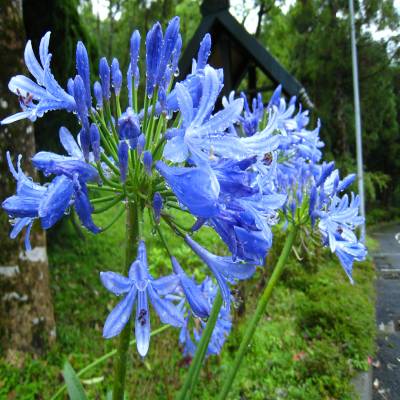
Lily of The Nile (Agapanthus africanus)
The Lily of The Nile (also called the African Lily) is a perennial herbaceous plant part of the Amaryllis family of flowers. It grows best in warmer climates with sword-shaped dark green leaves.
The flower of this plant comes in a dark violet to a blue color with exotic cluster blooms that shoot out in star patterns. It is a prolific bloomer from July to September and does best in USDA Zones 5-10. The Lily of The Nile thrives in full sun to partial sun and makes an excellent landscaping flower.
2. Globe Thistle
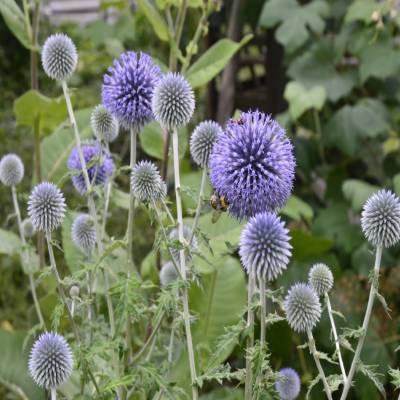
Globe Thistle
The Globe Thistle yields deep violet-blue round pom pom-style blooms that are great for summer border gardens. However, the spiny stem makes it easy to confuse a weed until the spherical blue blooms make their big entrance in the Summertime.
This perennial plant does best in various USDA Zones from 3-10. However, it doesn't tolerate poor soil conditions preferring dry soils with small amounts of organic matter.
Full sunlight will make the Globe Thistle an excellent container plant that will attract butterflies and birds. In addition, the blooms are an exotic way to level up a flower bouquet from your garden.
3. Blue Iris
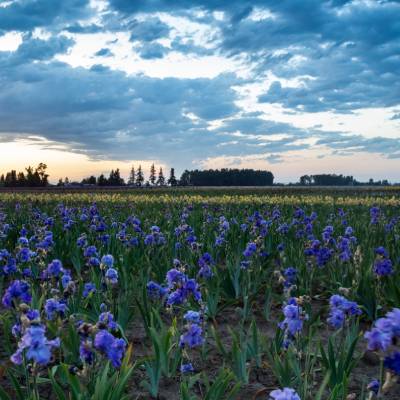
Blue Iris
The Blue Iris is said to symbolize faith and hope and will make a vibrant focal point for your landscaping. Although blue flowers are rare, there is no shortage of blue hues to pick from when planting Irises.
The Blue Iris is a tall grower that can max out at 3-5 feet. The blooming season is from late Spring to late Summer, when they will create a striking display and make long-lasting cut flowers. They have delicate petals that often feature a streak of yellow.
The Iris is typically an annual plant, but there is a possibility to get a second bloom if you take care to remove the spent flowers and leave as much of the stem and foliage behind as possible.
4. Grape Hyacinth (Muscari armeniacum)
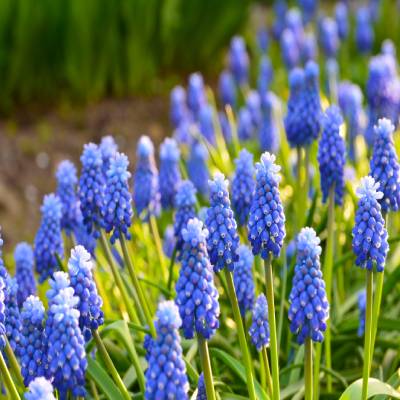
Grape Hyacinth (Muscari armeniacum)
The Grape Hyacinth is a great way to introduce blue hues into your garden landscape. The bloom is a cluster of bell-shaped cobalt blue buds that resemble a grape bunch. As a bonus, they are also very aromatic and give off a musk that is easy to identify.
Each bulb will grow 4-8 inch high stalks with 20-40 packed flowers per stalk. Each floret features a delicate white band around the rim of the bud. In addition, the floppy bright green elongated leaves give this plant a full foliage effect.
The Grape Hyacinth thrives in USDA Zones 3-9 with a preference for well-drained soil and full to partial sun; however, the flowers will bloom longer in a position in partial shade.
5. Himalayan Blue Poppy (Meconopsis betonicifolia)
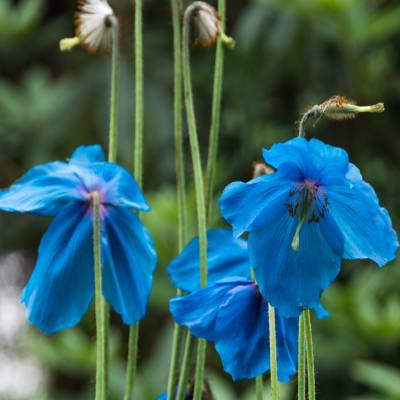
Himalayan Blue Poppy (Meconopsis betonicifolia)
The Himalayan Blue Poppy is an enchanting way to bring blue to your pots and planters around your garden. This variety of poppy has a rich "true blue" tone with a yellow center. They create a spectacular blooming show from late Spring to early Summer.
Although they sometimes get a bad rap for being difficult to grow, a little knowledge will have them blooming with ease. They should be planted in partial shade and protected from high winds. The Himalayan Blue Poppy prefers rich, well-draining soil and balanced organic or slow-release fertilizer as they are heavy feeders.
If you want to push your poppy beyond annual status, try pinching back the flower buds the first year to encourage perennial growth.
6. Colorado Blue Columbine (Aquilegia caerulea)
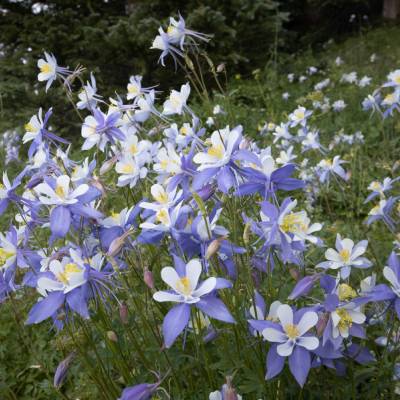
Colorado Blue Columbine (Aquilegia caerulea)
The Colorado Blue Columbine plant, also known as the "Granny's Bonnet," is a violet-blue and white crowd pleaser. It is an easy grower perennial that features bell-shaped spurred blue blooms from mid-Spring to early summer.
This flower is sensitive to high temperatures and will produce more vibrant blue blooms in cooler conditions.
This perennial flower can reach 1-2 feet in height and features light green foliage. They thrive in full sun to dappled shade conditions and prefer well-drained soil that stays evenly moist. The Columbine prefers sandy and loamy soil profiles and mulch to help the root system stay moist and cool.
7. Desert Bluebell (Phacelia campanularia)
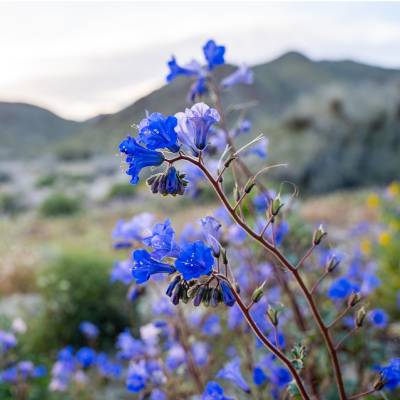
Desert Bluebell (Phacelia campanularia)
The Desert Bluebell is a showy flower that produces large bell-shaped vivid blue blooms. They occur naturally in California deserts, preferring the dry, full sun climate. Their leaves are oval and covered with fine hairs.
These annual herbs prefer arid soil in USDA Zones 9-10. Flowers will start to appear around February and March, with blooms lasting only a month. Occasionally, after a particularly wet winter, they will flower in masse, creating a sea of blue in your garden.
They are robust native plants that can take care of themselves- they don't need fertilizer or excessive watering in the right climates. They do not require irrigation and will make do with whatever water is available.
8. Greater Honeywort (Cerinthe major)
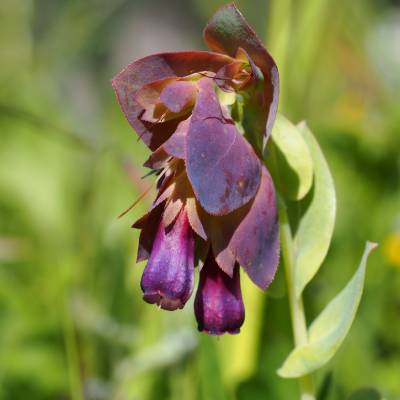
Greater Honeywort (Cerinthe major)
The Greater Honeywort is most identifiable by its bracts - a modified leaf with a deep blue and purple flower at its axil. These vibrant flowers show their colors for weeks and are showier than the actual flower, which is a small cobalt-colored bell-shaped blossom within the bract. The flowers are nectar-rich, making it a great gathering spot for pollinators.
The Greater Honeywort thrives in full sun and will give the brightest blooms in these conditions. It can, however, survive with partial shade. It prefers USDA Zones 7-10.
The Honeywort is happy in various soil conditions, making it an easy grower. Soil rich in organic matter that retains moisture but drains easily is its sweet spot. Once established, the Honeywort can take periods of drought and is hardy in weather changes.
9. Gentian (Gentiana)
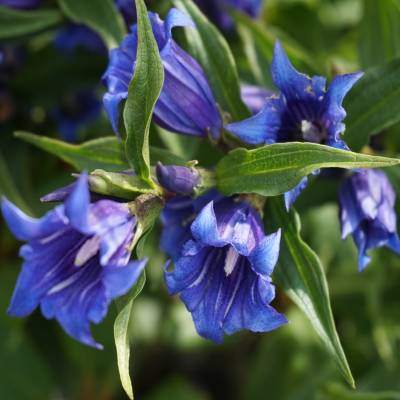
Gentian (Gentiana)
Gentian is not only a medicinal herb, but it can also add an artisan splash to your backyard blooms. This plant is a North American native that produces large, showy clusters of sapphire-colored 2" blooms.
They produce tubular-shaped flowers that resemble a closed bud. Although closed, pollinators love these blooms and make their way inside the flower by pushing themselves into the buds.
Gentian grows well in moist environments near ponds and moist wooded areas. It prefers partial sun and rich, cool, well-drained, moist soil. When planted within its preferred environment, Gentian will spread to form long-lived colonies of blue flowering plants.
10. Cornflower (Centaurea cyanus)
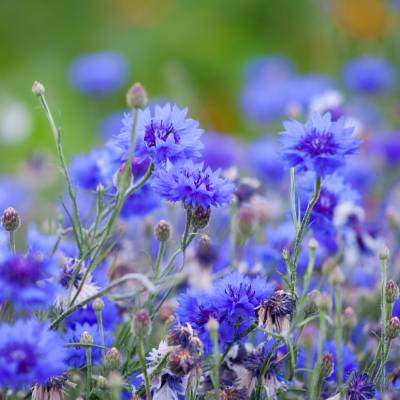
Cornflower (Centaurea cyanus)
The Cornflower is the "classic fantastic" of artistic gardening, a reliable self-sowing annual that just can't stop blooming. Once they are planted and established, they will come back year after year. They have a deep blue-violet color from the center to the outer petal. The color blue produced by the Cornflower is so vibrant that it can be used as a natural dye.
Cutting the blooms can make a beautiful addition to a bouquet with flowers lasting up to 10 days.
The Cornflower fits in both a rustic country garden and an elegant estate in equal bright blue measure. They are great for beds and borders and bloom from late Spring and summer into the fall.
Recent Articles

















